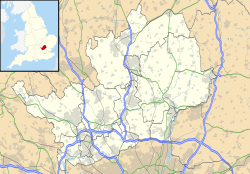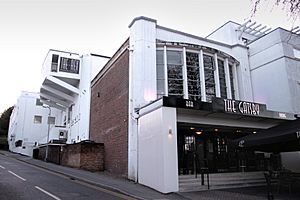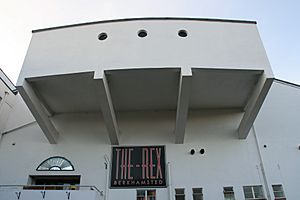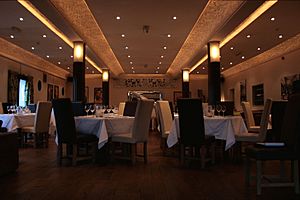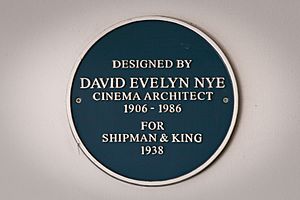The Rex, Berkhamsted facts for kids
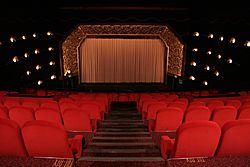
The Rex auditorium
|
|
| Address | High Street Berkhamsted England, UK |
|---|---|
| Coordinates | 51°45′32″N 0°33′37″W / 51.758809°N 0.560389°W |
| Owner | Nicholas King Homes |
| Designation | listed Grade II |
| Capacity | 350 (originally 1100) |
| Construction | |
| Opened | 1937 |
| Closed | 1988 |
| Reopened | 2004 |
| Architect | David Evelyn Nye |
| Tenants | |
| James Hannaway | |
| Website | |
| www.therexberkhamsted.com | |
The Rex is a cool cinema in Berkhamsted, Hertfordshire, England. It was designed in the awesome Art Deco style by David Evelyn Nye in 1936. The cinema first opened its doors in 1938.
After serving the community for 50 years, The Rex closed in 1988 and became empty. But people wanted to save it! Thanks to a local hero, the cinema was protected as a Grade II listed building by English Heritage. After a big effort, The Rex re-opened in 2004.
Today, it's a busy independent cinema. It shows movies almost every day of the year! You can watch anything from old classic films to new blockbuster hits. People often line up to get tickets for the popular shows.
Contents
The Rex: A Look Back in Time
Before The Rex cinema was built, a very old house called Egerton House stood on the same spot. This Elizabethan mansion was about 350 years old! It was built when Queen Elizabeth I was on the throne.
The house was also famous because J. M. Barrie, the writer of Peter Pan, had friends who lived there. These were the Llewelyn Davies boys, who inspired the story of Peter Pan. Egerton House was taken down in 1937 to make space for The Rex Cinema.
Building a New Cinema
In the 1930s, Berkhamsted already had a cinema called the Court Cinema. A company called Shipman & King bought it and wanted to build another cinema in town. They chose the site of Egerton House because it was close to the town center and had lots of room for a cinema and a car park.
After Egerton House was demolished, The Rex Cinema was built. It officially opened on May 9, 1938. The first movie ever shown there was Heidi, starring the famous child star Shirley Temple.
Changes Over the Years
In the 1970s, fewer people went to the cinema, and The Rex wasn't making much money. In 1973, a new company took over and changed its name to Studio 1. They started showing movies only a few days a week. The rest of the time, the building was used for Bingo, which was very popular back then. The dining room even got fruit machines!
In 1976, the cinema changed hands again. The new owners made big changes. They split the main movie room into three parts. The upper part (the circle) became two smaller screens, Studio 1 and Studio 2. The lower part (the stalls) became a full-time bingo hall. The last movie shown on the big screen before these changes was Rollerball.
The Cinema Closes Down
In 1988, The Rex closed its doors for good. The owners wanted to tear it down and build new offices and apartments. The very last movies shown were The Witches of Eastwick and Teen Wolf Too.
But people in the town fought to save The Rex! They convinced English Heritage to protect the building because of its special design. An inspector agreed that the cinema was important to the town's look and that its inside features should be saved. This meant the building could not be torn down.
Many ideas were suggested for the building, like turning it into offices or a health spa, but none of them worked out. In 1994, a fire damaged the stage area. The building became very run down.
Saving The Rex
In 1997, a local group called Friends of the Rex was formed. Their goal was to save the cinema and turn it into a film center. Famous film critic Barry Norman supported them, along with actors like Hugh Grant, Hayley Mills, and Ian Richardson.
Even the UK Parliament discussed the sad state of The Rex. But the government didn't offer money to help restore it. Still, the local campaigners kept trying!
The Rex: Amazing Art Deco Design
The Rex was designed in a stunning Art Deco style by architect David Evelyn Nye. Art Deco is a cool, geometric style from the 1920s and 30s.
When the cinema first opened, you entered through a curved doorway on the corner of the High Street. Inside, a huge Art Deco chandelier hung from the ceiling. There was also a curved ticket booth where you bought your tickets.
Moviegoers could go up steps to the lower seats (the stalls) or use two staircases to reach the upper seats (the circle). The main movie room was built sideways to the road. To save space, the projection booth (where the movie projector is) was built sticking out from the building! It was supported by big concrete brackets. People used to joke that the architect forgot the projection room and added it later!
The inside of The Rex had many fancy details. There were cool flower designs around the dining room and a decorated ceiling in the lobby. The dining room even had porthole windows, like on a ship! The auditorium had scallop shell-shaped lights and wavy designs. The big screen was framed by a beautiful arch with Art Deco flower patterns.
Restoring The Rex
Over the years, some of the original features were lost, like the chandelier and the ticket booth. And as you read, the main movie room was divided up.
However, even after years of being empty, most of the original design and decoration were still there. This is why English Heritage decided to protect the building.
When The Rex was finally fixed up and re-opened in 2004, it became smaller. It now has 350 seats, compared to the original 1100. This is because they added more legroom and comfy swivel chairs with cocktail tables. The restoration kept the cinema's Art Deco style. They even put in a new chandelier and cool period-style mirrors.
A big change was made to the ground floor. It's now a separate bar and restaurant called The Gatsby. It's named after the 1949 movie The Great Gatsby, and its poster hangs above the bar.
Now, when you go to the cinema, you use a side entrance and staircase to get to a smaller ticket area. The lower part of the movie room now has lounge chairs and tables.
Inside the cinema, there's a special plaque. It was put there in 1979 by actress Jane Asher. It reminds everyone that the site is connected to J.M. Barrie and Peter Pan.
Images for kids


